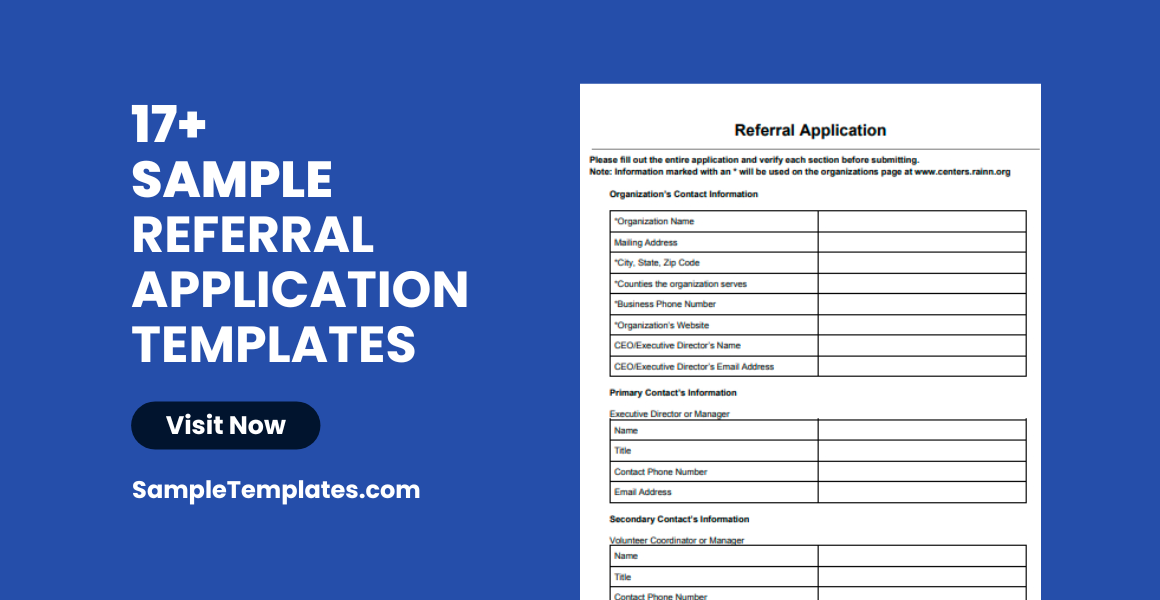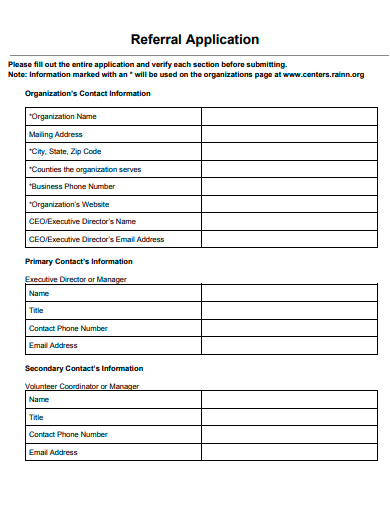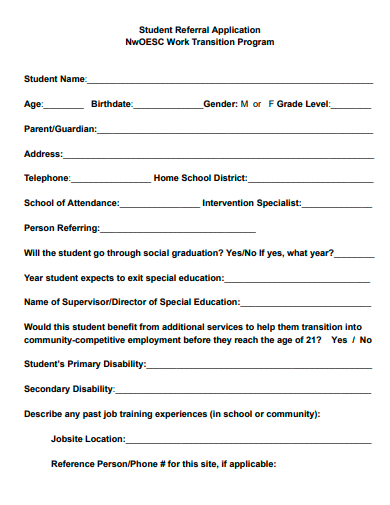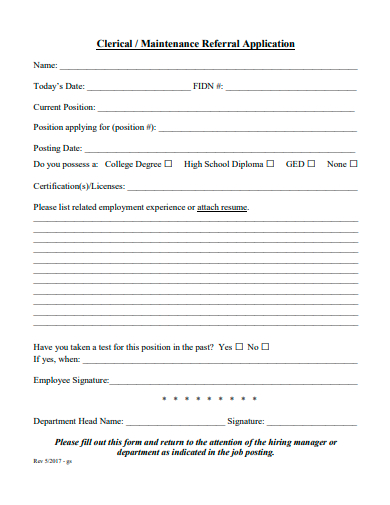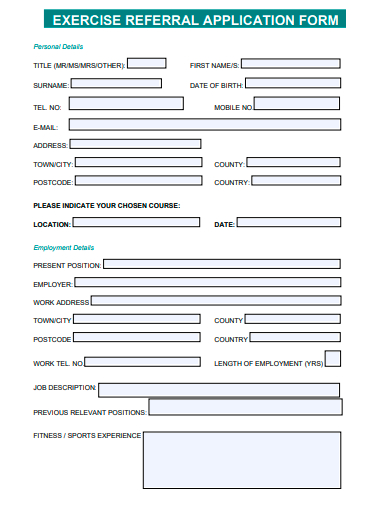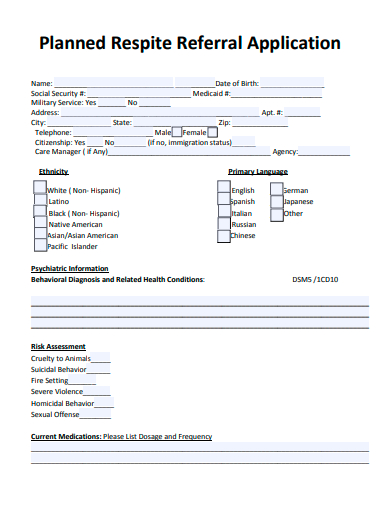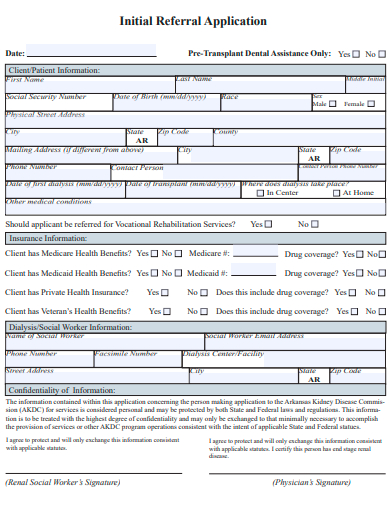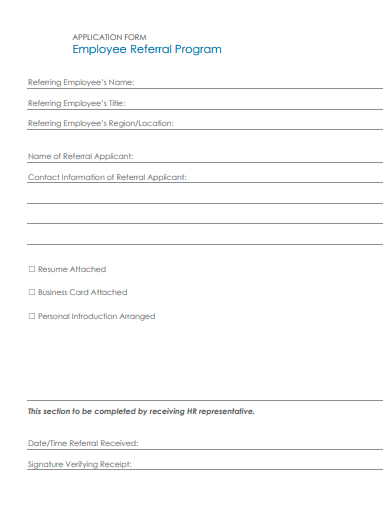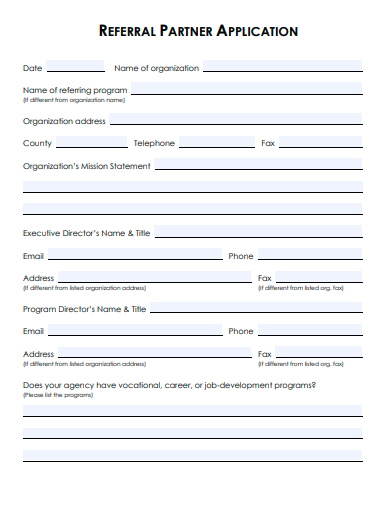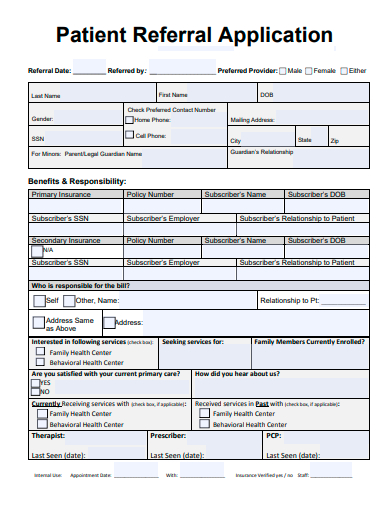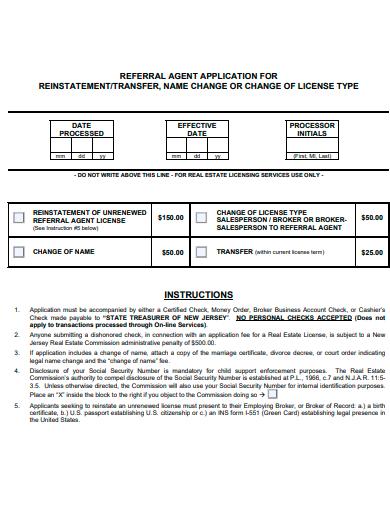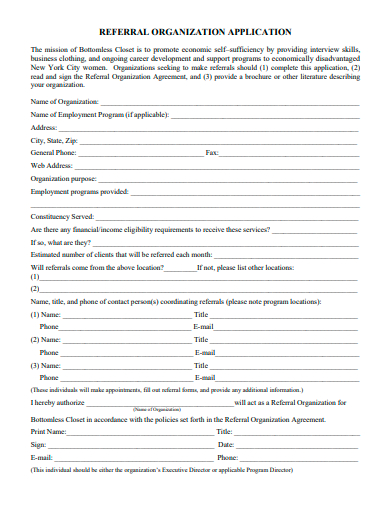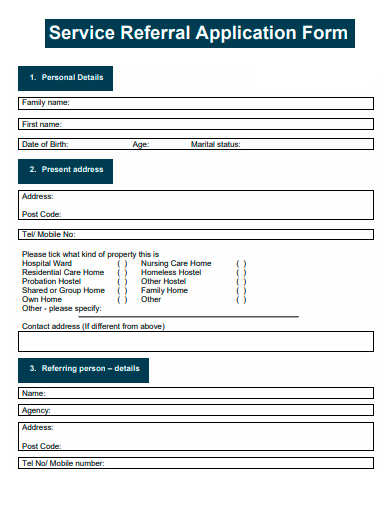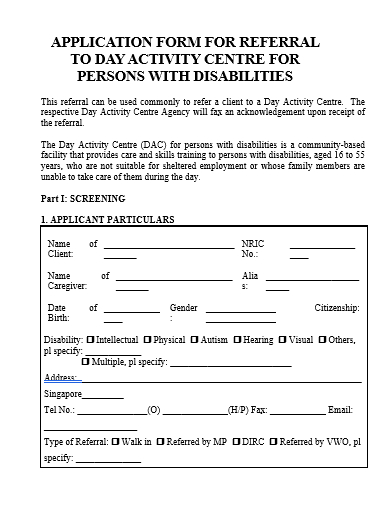In the interconnected world of business and services, the ‘Referral Application’ stands as a bridge to untapped potential. Designed to introduce and recommend individuals or services, it amplifies opportunities and strengthens professional networks. Whether for job prospects, specialized services, or partner sample programs, a detailed Referral Application showcases trust and credibility. Explore our comprehensive guide to understand its essence, design specifics, and the transformative impact it wields in fostering beneficial collaborations.
17+ Referral Application Samples
1. Sample Referral Application Template
2. Sample Student Referral Application Template
3. Sample Maintenance Referral Application Template
4. Sample Exercise Referral Application Form Template
5. Sample Planned Respite Referral Application Template
6. Sample Initial Referral Application Template
What is Referral Application?
Introduction to Referral Applications
A referral application, in the context of a digital document, is a formal request or recommendation from one entity to another, seeking services, advice, or further action. These applications are commonly used in the fields of medicine, law, and finance, among others. You can also see more templates like Sample Referral Forms.
Purpose and Importance
The main purpose of a referral application is to formally communicate the need for specialized services or attention that the referrer believes another entity is better suited to provide. It ensures that pertinent information about the individual or situation in question is transferred efficiently and accurately.
Key Components of a Referral Application
- Referrer Details: This section typically includes the name, designation, contact details, and affiliation of the individual or organization making the referral.
- Referee Details: Here, the information about the entity to which the referral is being made is provided, such as name, department, or specialty.
- Reason for Referral: A detailed description highlighting the reasons for making the referral, often specifying the expertise or services required.
- Background Information: This may contain historical data, previous observations, tests, or any other pertinent information that the referee should be aware of.
- Requested Action or Service: A clear sample statement of what is expected from the referee, be it an sample assessment, a treatment, a consultation, or any other service.
- Attachments or Supplementary Data: In some cases, referral applications may have additional documents attached to provide deeper insight or necessary records.
The Digital Advantage
Given that these are digital documents, it’s worth noting the advantages they bring:
- Efficiency: Faster transmission between parties.
- Accessibility: Can be accessed from any device, anywhere, as long as one has the necessary permissions and credentials.
- Reduction in Errors: Digital forms can have built-in checks to ensure all required information is provided.
- Eco-friendly: Reduces the need for sample paper, contributing to environmental sustainability.
Making the Most of Referral Applications
For a referral application to be effective, clarity is crucial. The information should be concise, yet comprehensive, ensuring the referee has a clear understanding of what’s expected. Furthermore, maintaining the privacy and confidentiality of data is paramount, especially when dealing with sensitive information. You can also see more templates like Teacher Application Samples.
Understanding the Role of Referral Applications in Different Sectors
1. Healthcare
In the realm of healthcare, referral applications play a pivotal role. When a primary care doctor encounters a medical situation that requires specialist intervention, they use a referral application. This ensures the specialist has a clear background of the patient’s history, symptoms, and any prior treatments.
- Benefits in Healthcare: Digital referral applications in healthcare can reduce waiting times, ensure timely medical interventions, and provide holistic patient care by sharing comprehensive data between doctors.
2. Legal Field
Lawyers and legal practitioners may use referral applications when they come across a case outside their expertise. For instance, a criminal lawyer might refer a copyright infringement case to an intellectual property attorney.
- Benefits in the Legal Sector: Digital documentation ensures that case details, client history, and prior judgments are meticulously recorded and shared, reducing redundant work and increasing the chance of favorable outcomes.
3. Financial Services
Banking and finance professionals can utilize referral applications when a client needs specialized services, like sample investment advice, mortgage consultation, or wealth management.
- Benefits in Finance: The seamless transition of financial data, client’s preferences, and risk profiles can help the referee provide tailored financial solutions, leading to enhanced customer satisfaction.
Challenges and Considerations
While referral applications, especially in their digital format, offer numerous benefits, there are challenges to consider:
- Data Security: Protecting the personal and sensitive data shared in these applications is paramount. Proper encryption methods and access restrictions need to be in place.
- Interoperability: With multiple systems in use across sectors, it’s crucial for referral applications to be compatible and interoperable to ensure seamless data flow.
- Updates and Revisions: Since these are digital documents, it’s easier to update them. However, it’s crucial to ensure that all parties have the most updated version to avoid miscommunications or outdated information.
Future of Referral Applications
As technology evolves, we can anticipate further advancements in referral applications:
- Integration with Artificial Intelligence: Future systems might automatically sort and prioritize referrals based on urgency, using AI algorithms.
- Real-time Collaboration: Enhanced platforms might allow multiple parties to collaborate on a referral design document in real-time, streamlining discussions and decisions.
- Analytics: Advanced systems could offer analytics on referral trends, helping organizations understand common reasons for referrals and potentially address them at their root.
How to Fill a Referral Application?
Filling out a referral application accurately is crucial to ensure the appropriate and timely services or interventions are provided to the individual or entity in question. The following guide provides a step-by-step process to help individuals fill out a referral application effectively.
1. Start with Personal Details
- Referrer’s Information: Begin by filling in your name, designation, contact details, and affiliation. Ensure that your contact information is accurate, as it may be used for follow-up questions or clarifications.
- Referee’s Information: Input the details of the entity or specialist to whom the referral is directed. This might include their name, department, contact information, and specialty.
2. Clearly State the Reason for Referral
In this section, provide a concise yet comprehensive explanation of why you’re making the referral. Be specific about the expertise or services you seek.
For example:
- For medical referrals: “Patient shows signs of a neurological disorder that requires specialist evaluation.”
- For legal referrals: “Client needs expert advice on intellectual property rights in the tech industry.”
3. Provide Detailed Background Information
Offer a background on the individual or situation for which the referral is made:
- Medical History: For medical referrals, provide information about the patient’s medical history, current medications, allergies, and any previous diagnoses.
- Case Details: In a legal scenario, offer an overview of the case, any previous judgments, and relevant legal documents.
- Financial Profile: For financial referrals, include details about the client’s financial position, risk tolerance, and investment history.
4. Clearly Define the Requested Action or Service
Outline explicitly what you expect from the referee. Whether it’s a consultation, a specific test, a legal review, or a financial audit, be as specific as possible.
5. Attach Relevant Documents
Given that it’s a digital referral application:
- Ensure you attach any necessary supplementary data or documents.
- Ensure files are appropriately named for easy identification.
- If there are privacy concerns, ensure documents are encrypted or password-protected.
6. Use an Easy-to-Read Format
- Bullet Points: Use them for sample lists or when highlighting key points.
- Short Paragraphs: Keeps the document readable and ensures key points stand out.
- Bold or Italicize: Use these for emphasis, but sparingly.
7. Review Before Submission
Before hitting the ‘submit’ or ‘send’ button:
- Proofread for any spelling, grammar, or factual errors.
- Ensure all required sections are filled.
- Confirm that all attached documents are correct and openable.
8. Follow Up
Once the referral application is sent:
- Make a note to follow up after a specific period, especially if you haven’t received acknowledgment of receipt.
- Be available to provide further information or clarification if required.
7. Sample Employee Referral Program Application Form
8. Sample Mandatory Referral Application Template
9. Sample Referral Partner Application Template
10. Sample Lawyer Referral Service Application Form
11. Sample Patient Referral Application Template
12. Sample Referral Agent Application Template
13. Sample Referral Organization Application Template
14. Sample Member Referral Application Template
15. Sample General Plan Referral Application Template
16. Sample Referral Bonus Application Template
17. Sample Service Referral Application Form Template
18. Sample Activity Referral Application Template
How do you Create a Referral Application?
Creating a referral application helps businesses or organizations gather information about potential candidates or clients through existing associates, employees, or partners. A well-designed referral application can streamline the process and ensure you get quality referrals. Here’s how you can create one in five detailed steps:
Step 1: Purpose & Introduction
Begin by clearly defining the purpose of the referral application. Whether you’re seeking new clients, candidates for job positions, or members for a club or organization, make this clear. Provide a sample brief overview of the program, emphasizing benefits for the referrer, like incentives, rewards, or recognition they might receive. This introduction sets the tone and encourages quality referrals.
Step 2: Referrer’s Information
Collect comprehensive details about the person making the referral. This includes:
- Name and surname
- Contact details (email, phone number)
- Relationship to the referred individual
- Department or team (if within an organization) Understanding the referrer’s background can help in gauging the reliability of the referral and ensuring proper rewards or recognition.
Step 3: Details of the Referred
This section gathers information about the person or entity being referred:
- Name and surname (or business name)
- Contact details
- Professional background or business profile
- Specific skills, achievements, or offerings (for job candidates or service providers)
- Any other relevant details that can provide insight into the referred individual’s qualifications or compatibility.
Step 4: Referral Context
Provide space for the referrer to explain the context of their recommendation. Why do they believe the referred individual or entity would be a good fit? This can include personal anecdotes, professional experiences, or specific traits they’ve observed. This qualitative data can be invaluable in understanding the strengths of the referred individual beyond just their CV or sample portfolio.
Step 5: Terms, Conditions, and Declarations
End the application format by outlining any terms and conditions associated with the referral process. This can include potential rewards, sample timelines for evaluation, or any disclaimers. Include a declaration section where the referrer confirms the accuracy of the information provided and acknowledges the terms of the referral program. Ensure they have space to sign and date the application, which affirms their understanding and sample agreement.
In Conclusion, a referral application, as a digital document, serves as a bridge between entities, ensuring the smooth transition of information and fostering collaboration. When used correctly, it can greatly enhance the efficiency and effectiveness of processes, ensuring that individuals or cases get the specialized attention they require.
Related Posts
FREE 29+ Student Application Form Samples in PDF | MS Word
FREE 21+ Administrative Application Samples in MS Word | Apple Pages | PDF
FREE 21+ Teacher Application Samples in MS Word | Apple Pages | Outlook | PDF
FREE 25+ Transfer Application Samples in MS Word | Apple Pages | PDF
FREE 23+ Participation Application Samples in MS Word | PDF
FREE 14+ Patient Application Samples in MS Word | PDF
FREE 21+ Eligibility Application Samples in PDF
FREE 20+ Travel Application Samples in PDF | MS Word
FREE 25+ Sponsor Application Sampales in MS Word | Google Docs | Apple Pages | PDF
FREE 23+ Candidate Application Samples in PDF
FREE 33+ Committee Application Samples in PDF | MS Word
FREE 37+ Supplemental Application Samples in PDF | MS Word
FREE 37+ Product Application Samples in PDF | MS Word
FREE 33+ Visiting Application Samples in PDF | MS Word
FREE 34+ Refund Application Samples in PDF | MS Word
